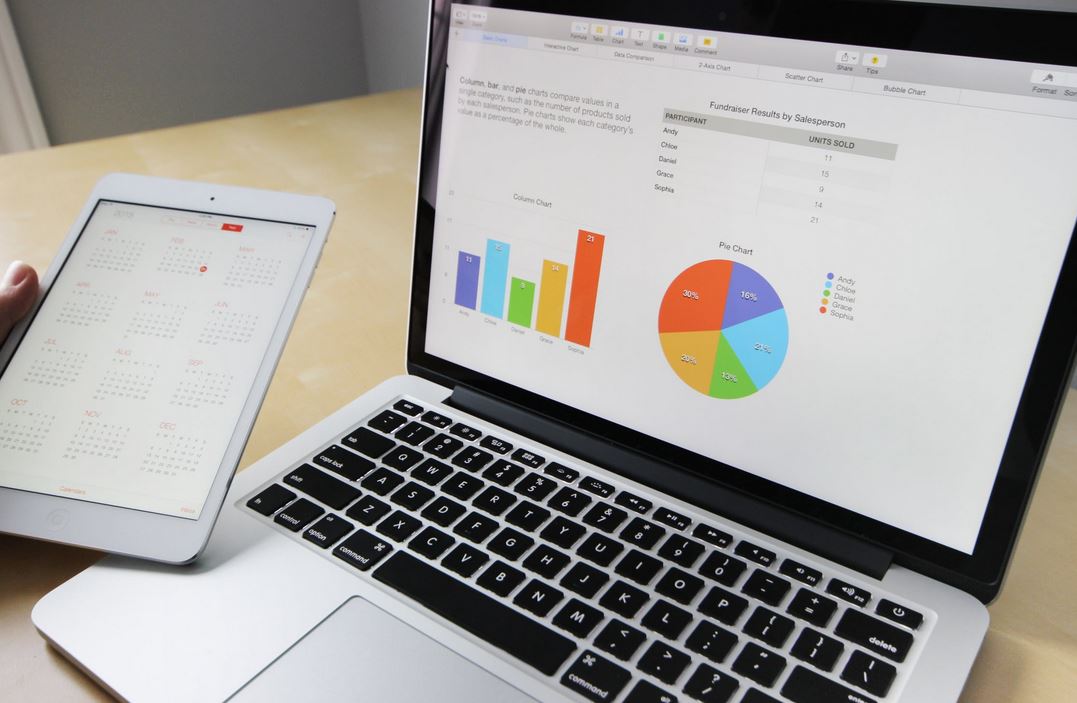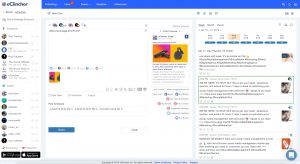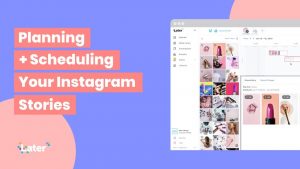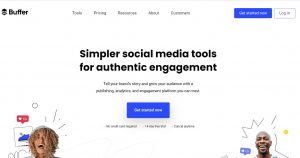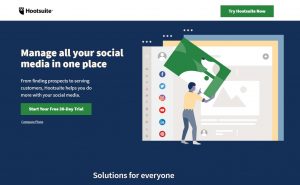Are you struggling to manage your social media pages? Like many small business owners, you may not have enough time to regularly post on different social channels, let alone monitor them. This is why it’s important to use tools that feature post scheduling, page insights, and a unified messaging system. It’s not always feasible to hire a social media manager, and even if you decide to, they would still need to use these tools to make the process easier. For this, we’ve come up with a list of the best social media management tools to help you keep track of your pages and run marketing campaigns that work.
What Is a Social Media Management Tool?
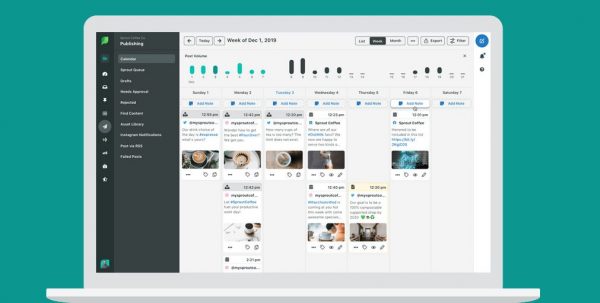

A social media management tool or platform is an application that helps you manage your pages in one place. This guide focuses on browser-based platforms because they are more efficient than mobile apps. These tools help you automate tasks for you like posting content and filtering comments. They usually allow you to manage pages from different social channels in one place. Using social media management apps will save you a lot of time so you can focus on the more important tasks like devising ad campaigns and increasing your sales.
What do they look like and how do you use them? When you go to your dashboard, you will usually find a set of “streams” that show you your content on each page. You will see a column for each page and from there, you can edit or delete posts, and manage comments. Depending on the capabilities of the social management tool, it may also include a calendar where you can lay out your marketing campaigns and keep track of their performance.
There are plenty of platforms out there, both free and paid, but how do you choose one? The best social media management tools combine these features in an easy-to-use interface. You will find more information about each feature in the latter part of this article.
Why Is It So Important for Small Businesses?
The most important reason to use a social media management tool is to create a social presence which will, in turn, help you increase “brand awareness” and eventually convert interactions to sales. More information about brand awareness below.
These days, it’s incredibly important for small businesses to establish a social media presence. Even brick-and-mortar establishments are growing their own e-commerce business. No matter the niche of your small business, you need social media to reach more people and lead them to you. It’s also more secure to use a social management tool if someone else is managing your pages. This way, they don’t have to log in to your accounts natively—meaning they don’t need your Facebook or Instagram password. Native access means going to the official Facebook site to log in.
You may be wondering if you should pay for a subscription or premium features or use the free ones. The truth is a lot of free plans just don’t have enough capabilities and often, it’s better to manage your pages natively than to use them. Managing pages natively means going on the official Facebook, Instagram, or YouTube app to manage your content. In the long run, paying for a subscription is a good investment, but it’s also worth trying the free features first.
12 Best Social Media Management Tools Every Small Business Needs
This list is compiled based on each tool’s usability, value for money, and genuine customer reviews.
1. Hootsuite
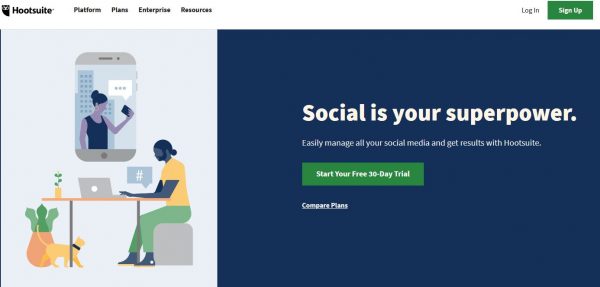

Hootsuite is one of the most-used social management tools both by small and big businesses. A lot of business owners and professional social media managers prefer this tool because of its interface. It features multiple platform integration as well as third-party app integration. That means you can also manage business tools like Trello, Slack, etc. within the app. It’s also one of the few platforms that support YouTube integration.
Why It Stands Out
Bulk Scheduling
Upload multiple posts at once and schedule them on different days and times. Other platforms only allow you to schedule up to a week in advance but Hootsuite lets you post content months ahead. This is the best social media management tool for those who want to layout long-term marketing campaigns.
Hootsuite Academy
When you sign up, you will have access to Hootsuite’s learning center where you can find resources on building your social media skills.
Supported Platforms
- YouTube
Plans
Free
The free/limited plan allows you to manage three social media accounts and schedule up to 30 posts. Only one user is allowed to log in at a time.
Professional
This plan is best for small businesses and entrepreneurs. You can manage 10 pages but you also get only one user. This plan gives you $500 to use on paid promotions and access to advanced reporting tools.
$29/month
Team
This is Hootsuite’s best social media management tool for businesses run by small teams. It allows up to three users to log in so you can assign tasks to other team members. You will get $2,000 to boost your posts and access to custom reports. You can manage 20 pages in one account.
$129/month
Business
The business plan is for bigger teams that have a social media marketing department set up. You can assign up to 10 people to manage the account, each having their own login credentials. It allows you to manage up to 35 social media pages and have the same access to reports as the two paid plans.
$599/month
Enterprise
This the platform’s best social media management tool for big organizations. It lets you manage more than 50 pages and includes a social listening feature and completely customized reporting. The pricing for this plan is customized based on your business’ needs.
2. Buffer
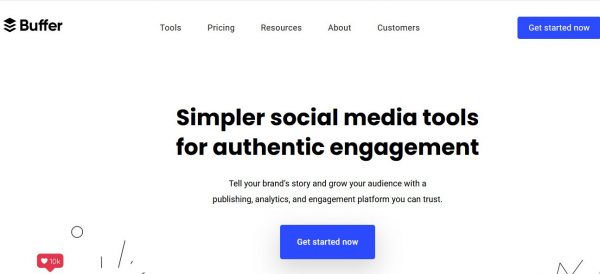

Buffer is one of the oldest social media management tools, and it has been used by individuals for their personal social media accounts because of its free tier. It’s great for startups to medium businesses. It is also one of the easiest to use.
Why It Stands Out
RSS Feed Integration
You can integrate your website or blog’s RSS feed. This automatically shares your blog posts to your social media accounts once they’re published. It’s great for businesses that have a decent amount of following on their website and that rely on website content to promote sales.
Unified Social Inbox
Buffer uses a third-party app called Reply, which gives you access to an inbox where you can receive and respond to messages sent to all your social media pages. Manage all your communication with fans and followers in one place.
Supported Platforms
Plans
Free
Connect up to three social media pages and schedule 10 posts in advance. You can connect pages from all supported social media platforms except Pinterest. It also features engagement analysis like comment sentiment—this tells you if the general sentiment on your posts is positive or negative. You get browser extensions, two-factor authentication (2FA), and integration to its compatible mobile apps.
Pro
You get to connect eight social pages, schedule up to 100 posts, and get one user. Unlike the free plan, you can connect your Pinterest page. Other additional features include a calendar view and Instagram tagging.
$15/month
Premium
The premium gives you all features of the Pro plan and a maximum of 2,000 scheduled posts for each social media page and two users. Upgrading from pro to premium gives you the hashtag manager tool, Instagram Stories, and the ability to assign tasks and manage permissions.
$65/month
Business
25 social channels, 2,000 scheduled posts, and six users. All other features are the same as the premium plan.
$99/month
3. Sprout Social
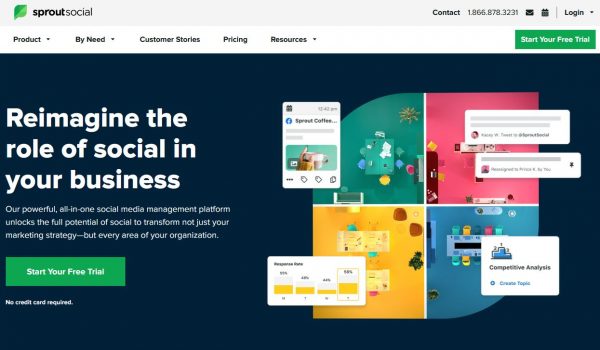

Sprout is popular among established brands and is the best social media management tool in terms of reliability. It is a scalable tool and adapts to your needs as your business grows. It’s a robust platform that is easy to use and has great social marketing features. Sprout does not have a free tier, but you can do a 30-day trial.
Why It Stands Out
Approval Workflows
Not only does Sprout let you manage your pages with a team, but it also features an approval workflow. This lets other team members post drafts, and you can assign someone to approve or disapprove them. It’s a very helpful feature for preventing mistakes. You can review each post before they are scheduled to check if there are spelling errors or any content that you may not want to be associated with your brand.
Individual Stats
Another powerful tool is the individual statistics feature that lets you view the performance of each post. This is useful when you are running several campaigns at once.
CRM Tools
CRM stands for customer relationship management. This lets you see your conversation history and customer’s contact information. Your team members will also be able to write internal notes so that others can see them in case they interact with the same user again.
Supported Platforms
- YouTube
Plans
Standard
Connect five social media pages, but you can purchase additional slots at a discounted price if you don’t want to subscribe to the higher plan. You will also get a unified inbox, social calendar, and CRM tools. Paid promotion tools are also included.
$99/month
Professional
10 social pages and multiple users. In addition to the standard features, you get advanced reporting, trend analysis for Twitter, and helpdesk integration. This lets you connect team management tools like Zendesk or HubSpot. You will also be able to assign multiple approvers. This is Sprout’s best paid social media management tool for small businesses to medium organizations.
$149/month
Advanced
In addition to all the professional features, you will get a digital asset and content library. This lets you store photos and written content on the platform so you can recycle/reuse them for future posts. You can also use chatbots if you want to set up automatic replies.
$249/month
4. Agora Pulse
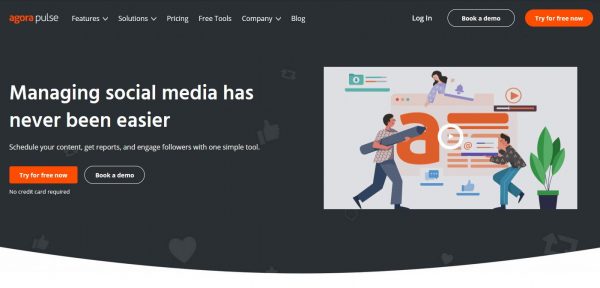

Agora has everything you need in terms of scheduling, messaging, and analytics plus competitor analytics, which is not offered by the first three platforms above. It does not have a free plan, but you can sign up for a 30-day trial.
Why It Stands Out
Competitor Analysis
See how your competitor’s social media pages are doing compared to your performance. This also lets you see which hashtags they are using on their posts and how effective they are.
Unlimited One-Click Reports
Instead of going to a reporting dashboard, you can immediately see stats for each of your posts in one click. See how much engagement you are getting and if your content strategy is working. You can also download these reports and save them as PowerPoint documents.
Supported Platforms
- YouTube
Plans
Pro
Connect 10 social media pages and two users per account. It features unlimited scheduled posts, a unified calendar for all your pages, CRM tools, and social listening. You will also get the Facebook competitor analysis tool.
$79/month
Premium
25 social profiles and four users. Unlike the pro plan, you can purchase additional profiles at a discounted price as well as additional users. In addition, you get a shared calendar, an automated inbox assistant/bot, and team reporting.
$159/month
Enterprise
Up to 40 social pages and eight users. In addition to all the premium features, you can assign a dedicated account manager and access quarterly business reviews. The pricing for the enterprise subscription is customized based on your needs.
5. Loomly
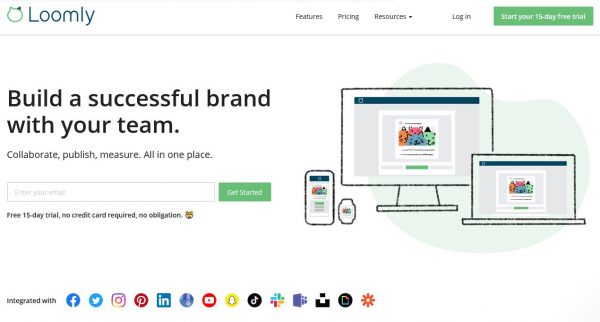

Loomly is the best social media management tool for those who need integration with the newer social media platforms like TikTok and Snapchat. These are not supported by the above websites. It’s a great choice for businesses that need to focus on branding and content creation. If you struggle with coming up with content ideas, it has features that can suggest content for you based on your past performance. One downside is it does not feature a unified social inbox.
Why It Stands Out
Post Ideas
Loomly provides marketing-focused content suggestions that will help with your ad campaigns. These suggestions are based on trending topics, events, and holidays.
Audience Targeting
Create filters to target your audience effectively. This can be based on age, location, other demographics, and the audience’s attitude toward paid content. You can also manage your boosted posts on your dashboard.
Supported Platforms
- YouTube
- Snapchat
- TikTok
- Google My Business
Plans
Base
Allows up to two users to log in to the account simultaneously and 10 social media pages. You will get all the core features including hashtag suggestions.
$25/month
Standard
Six users and 20 social profiles. You will get advanced analytics tools as well as content exporting.
$57/month
Advanced
16 users and 35 social media pages. Some extra features not offered in the base and standard plans include custom workflow, which automatically assigns tasks based on rules, and third-party team management app integration.
$119/month
Premium and Enterprise
The two highest tiers include all features plus custom branding. This lets you add your logo to all your social media pages and export reports in PDF format. The pricing for the enterprise plan is customized based on your needs.
$249/month and custom
6. Sendible
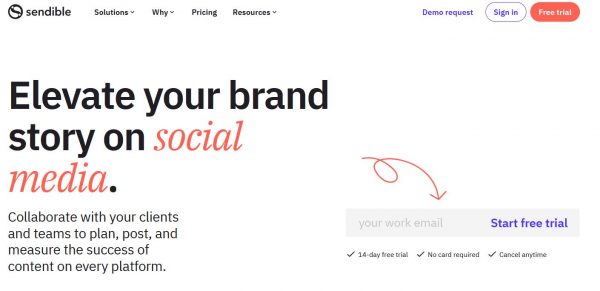

This is one of the best social media management tools for businesses that need to provide extensive customer support to their followers. It features advanced CRM tools and an auto-post feature. It also includes a unified inbox and social listening features. The platform doesn’t offer a free tier, but you can do a 14-day trial.
Why It Stands Out
Smart Queue
This allows you to recycle or reuse previous posts and schedule them for reposting. Only a few platforms offer this feature.
Influencer Interaction
Sendible does not have an influencer search tool but you can interact with influencers if you know their social media handles. Take note that these two are different features.
Supported Platforms
- YouTube
Plans
Starter
You can connect up to 12 social media pages, and you get one user per account. You will also get eight quick reports.
$29/month
Traction
Three users and 48 social pages. You get access to team management app integration and 15 custom reports.
$99/month
Growth
Seven users and 105 social media pages. It includes automation of tasks as well as workflow approval. You can build up to 35 reports.
$199/month
Large
Includes all the above features plus advanced tools that will help you build and customize your content. You get 12 users and up to 192 social media pages, and 60 custom reports.
$299/month
7. eClincher
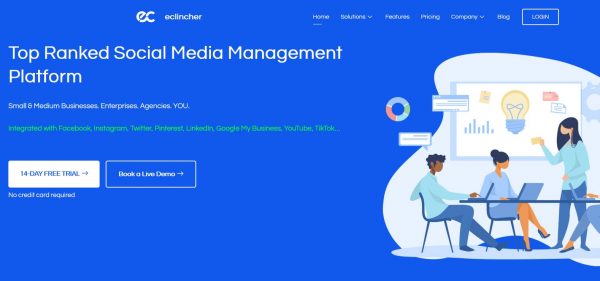

In terms of third-party app integration, eClincher is one of the best social media management tools. It focuses on automating marketing campaigns along with bulk scheduling and RSS feed integrations. It features auto-posting and a robust CRM system.
Why It Stands Out
Biggest Third-Party App Integration
This platform has perhaps the biggest third-party app integration. You can connect your team management apps like Zendesk and Slack, plus photo editing apps like Canva and Unsplash. You can integrate cloud storage services like Google Drive and Dropbox. This makes it easy for you to share marketing documents with your team.
Visual Calendar
With its visual calendar, you will not only see your scheduled written content but also the photos attached to them when applicable. This gives you an idea of how your page will appear after your images are posted, which is very useful for Instagram posts.
Supported Platforms
- YouTube
- TikTok
Plans
Basic
The basic plan lets you connect 10 social media pages. You get a unified social inbox, unlimited scheduled posts, and 15 auto-post queues. It lets you publish to your Instagram Stories directly on your dashboard and provides you with suggested hashtags. You will also have a visual calendar and access to social and web analytics.
$59/month
Premier
You get three users and 20 social media pages. Aside from unlimited scheduled posts, you will also have unlimited auto-post queues. Other extra features include a media library, competitor analysis, and team collaboration.
$119/month
Agency
Six users and 40 social pages. On top of the premier features, you will have a dedicated workspace for your brand. You also get unlimited shared calendars, which are not included in the other tiers.
$219/month
8. HubSpot
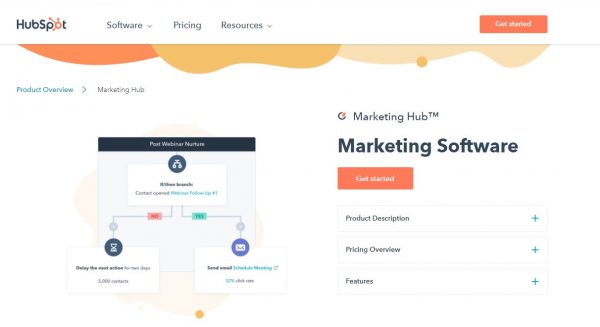

Hubspot is known for a variety of marketing tools, but it also have dedicated social media management tools included in its Professional package. Complete with social media scheduling tools, social listening, and custom reporting, plus all its digital marketing tools, HubSpot is a platform to manage your website and social pages in one place.
Why It Stands Out
Powerful Digital Marketing Tools
Since HubSpot is primarily for marketing, you will get its advanced marketing tools like email marketing, live chat for your website, ad targeting, and more.
Supported Platforms
Plans
Social management tools are only available on HubSpot’s professional and enterprise plans.
Pro – $890/month
Enterprise – $3,200/month
9. Falcon.io
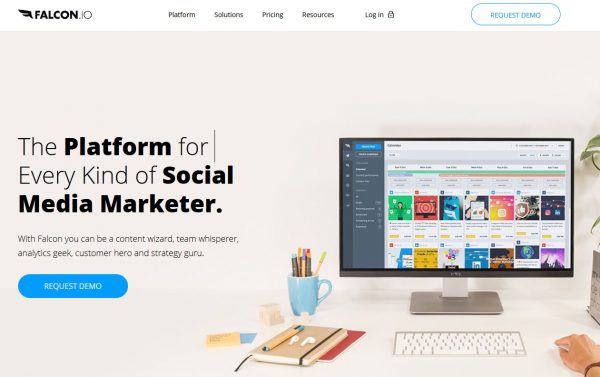

This social media management platform is unique because it is cloud-based. It has incredible social listening features, analytics, and customer data management. It’s quite versatile when it comes to social media marketing.
Why It Stands Out
Collaborative Content Calendar
Share your publishing calendar with your team so everyone can keep track of your campaigns both paid and organic. This includes an approval system so you can assign someone from your team to approve or disapprove drafts.
Supported Platforms
- YouTube
Plan
Falcon.io only has one plan that costs $129 a month.
$129/month
10. Later
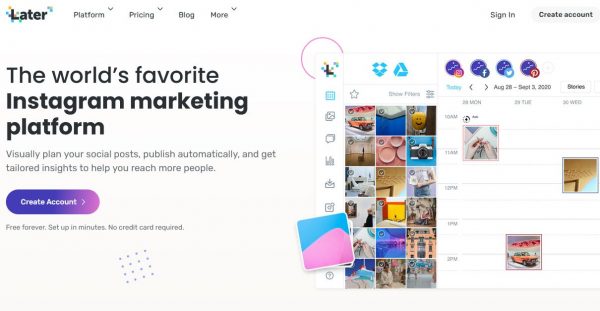

Later is most popular as a social media scheduler, hence the name. It used to be only for Instagram pages but has now integrated other social channels. The platform is best for visual planning with its intuitive visual calendar.
Why It Stands Out
Most Affordable
This is perhaps the most affordable social media management tool. With plans starting from $7 for personal use, it’s the perfect solution for small businesses that are just starting out.
Supported Platforms
- TikTok
Plans
The platform only has one plan for business accounts. This includes post scheduling for all your social media profiles, direct posting for Instagram Stories, and hashtag monitoring.
$12.50/month
11. Social Pilot
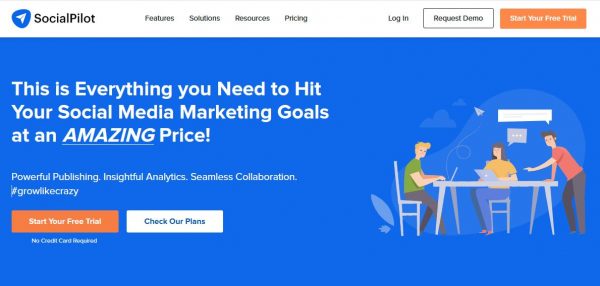

This is one of the best social media management tools in terms of workflow management. It’s best for businesses that work with marketing teams or businesses that handle multiple clients. It features a unified social inbox, influencer search, and auto-posting on top of all the basic features you can find on other platforms.
Why It Stands Out
Influencer Search
Notice that very few social media tools have this feature. It’s an important feature for businesses that invest in influencers to increase brand awareness. This will help you find influencers that fit your brand and easily interact with them.
Supported Platforms
- TikTok
Plans
Professional
Connect 25 social pages and allow up to three team members to log in simultaneously. You get the bulk scheduling feature, content curation, and analytics.
Small Team
Five users and 50 social media pages. You get unlimited client management on top of all the core features.
$42.50/month
Agency
This lets you manage up to 100 social media pages and allows 10 team members to log in at once. You also get web analytics aside from social media analytics, content curation, RSS feed integration, and access to PDF reports.
$85/month
Enterprise
Fully customized depending on your business’ needs. The pricing will also depend on the features that you choose.
12. Monday Marketing
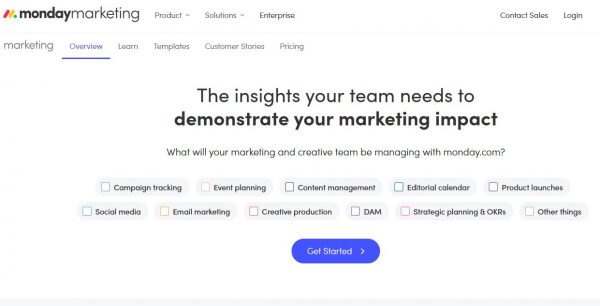

This platform provides you with plenty of digital marketing tools along with social media management. It features both a social media calendar and a general marketing calendar that you can manage in one place. It also features competitor analysis.
Why It Stands Out
Marketing Tools Integration
Monday Marketing lets you integrate its marketing tools with your social media scheduling tools. You will need to choose which marketing tools you want to be included in your plan.
Supported Platforms
Plans
Unlike most of the above platforms, Monday does not have fixed plans. When you sign up, you will have to customize your package and choose which features you need, and the pricing will depend on your choices.
Features to Look For
These are the critical features that you should look for when choosing which social media management tool is the best for your small business.
Post Scheduling
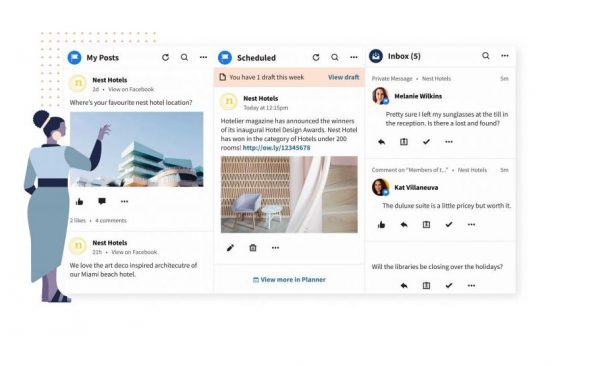

Nearly all these platforms have a social media scheduler feature, but what you should look for is how far in advance you can schedule your posts and how many posts you can schedule.
Notice that in the above list, this capacity differs based on the plan. Not all of them allow bulk scheduling. Some also limit you to only a month in advance of post scheduling. So if you are planning long-term social media marketing campaigns for your business, you need to choose a plan that offers unlimited post scheduling and for longer than a month.
Unified Inbox
This is another feature that is not always offered on all platforms and subscriptions but it is very important. If you are managing pages from different social media channels, you need an inbox that allows you to receive and respond to messages from different channels in one place. This will prevent you from missing inquiries, reviews, and complaints that can be detrimental to your brand.
It also allows you to respond in a timely manner. Customers don’t like it when businesses are unresponsive.
Website/Blog Integration
Also called RSS feed integration, a website or blog integration feature lets you share your web content or blog posts automatically to your social pages. This is a useful feature if you want to build authority for your brand.
Blogs help businesses share reliable information about their products and industry. This builds trust in your customers and being able to share those posts instantly to your pages will save you a lot of trouble. It will also drive more traffic to your site.
Multiple Social Channels
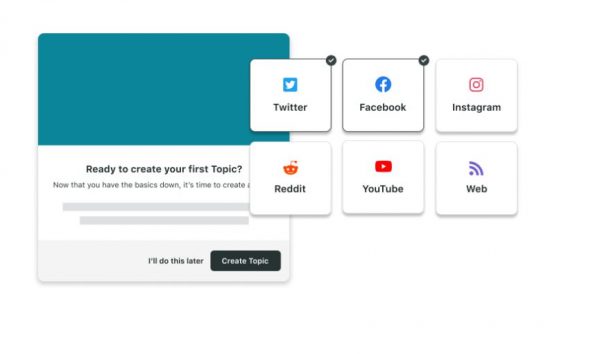

There is also a limit to how many social media pages or channels you can manage in one account depending on the platform and plan that you choose. You may not need a lot especially if you are running a small business, but it’s good to have the option to scale up.
Another thing you should look at is how many social platforms are supported. Do you also have a YouTube and Pinterest page? Make sure that those platforms are supported as well. Most services only offer integrations for Facebook and Instagram. If your business is active on LinkedIn, then you need a service that allows you to connect your LinkedIn page so you don’t need to manage it separately.
Multiple Users/Admins
Most services above offer only one user per account in their basic plans. Having only one user access can be very limiting and frustrating. If you have a social media manager, it means you would have to give your credentials to them. It would be good to have at least two users or admins on the account so that both you as the owner and whoever is managing your pages will have access. If you are planning to put up a social marketing team, then you need multiple users to be able to log in and also someone to manage permissions.
This is where the workflow feature comes in. With a workflow feature, you can assign someone to approve or disapprove scheduled posts. You will avoid a lot of problems this way because once something is posted online, your followers will remember it even if you take it down. What if someone in your team posted something offensive or inaccurate? It could ruin your brand reputation instantly.
Social Listening/Monitoring
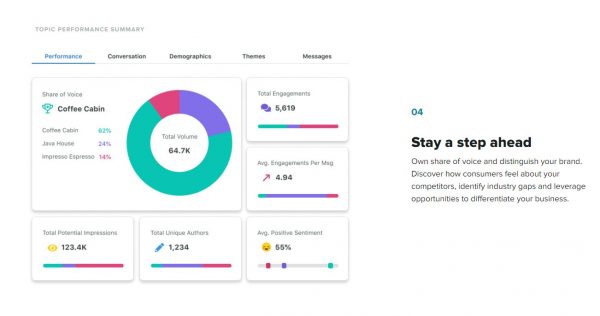

Social listening lets you gauge the sentiments in your posts. This feature analyzes the reactions and comments on your posts, mostly on Facebook. It lets you see whether a particular post has a general neutral, positive, or negative sentiment. Some also call them positive or negative engagement. It’s a great way to measure if your fans are liking what they see on your page. You can easily change strategies if your posts are not getting the results that you wanted.
Influencer Search
Not all brands or small businesses collaborate with influencers. If you want to work with them, however, the influencer search feature would be very useful. It would help you find people who may be able to promote your brand. While you can also search for them natively, it takes a lot more time and effort. With an influencer search, the platform will automatically suggest people whose activities are relevant to your brand.
Paid Promotion Tools
Running paid promotions helps you reach new people and get them to like your pages. You will eventually need to do this for your business to grow. While it’s important to have more organic (unpaid) posts, you will need to boost some of them especially if you are running a campaign. Tools like audience targeting, campaign analysis, and reporting are all crucial when you are doing paid promotions. They also let you monitor your ad expenses. How much are you spending on a boosted post and how well did it perform?
Marketing Calendar
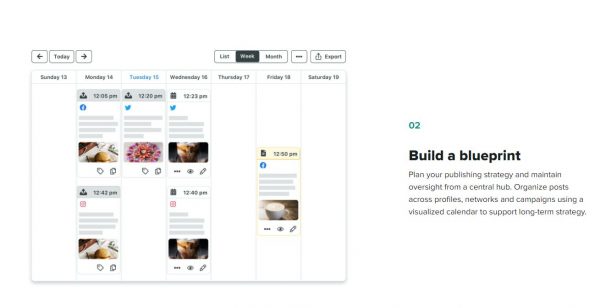

This is an incredibly necessary feature that you must have. It helps you plan your posts and spread them out accordingly.
Campaign Insights
These insights are not just limited to how many likes or comments you got on a post. It also includes information on your audience. How many of them are male or female? From what country or city is the bulk of your audience? What are their ages? It even tells you their age, ethnicity, and interests. This is important because it lets you know who you are reaching and if the reception from them is good or bad.
Reports
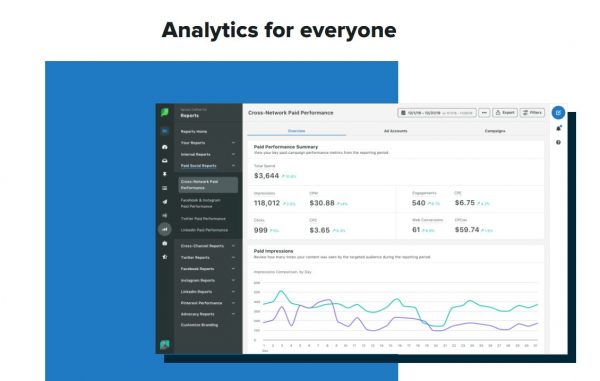

The best social media management tools offer custom reporting. Basic reports don’t tell you much in terms of how well your posts and pages are doing. They only give you numbers. Custom reporting, however, gives you more detailed information on particular metrics. These include your ad spend, how long it took you to achieve your social marketing goals, and so on. You should also check if you can download and print these reports in a PDF or PowerPoint format.
User-Friendly Interface
The platform may have everything that you need but how easy is the site to navigate? You must find a balance between having comprehensive tools and an intuitive interface.
Security
Remember that to use these management tools, you would need to provide your login information for your social media accounts. So look for services that offer enhanced security like two-factor authentication and login alerts.
How to Build Your Brand on Social Media
Using social media management tools is just one part of the equation. You also need to learn how to effectively build your brand to have a strong social presence.
Avoid Clickbait Posts
People are tired of clickbaits. The greater consequence is it can taint your brand’s reputation. You need to build trust in your following so you could retain them and gain new ones. If you post content from your website or blog, make sure that the information is relevant to the title or caption.
Tell Stories
Don’t just promote your products. Tell your audience the story behind it and give them something to relate to. What is it about your brand or products that people can see themselves in? What values do you promote? These are done through photos, videos, and written content as well.
Branding First, Sales Second


A mistake that most small businesses make is to go straight for sales. That has proven to be ineffective time and time again. Do you remember which commercials or ads stuck with you? Most likely, these are not the ones that asked you to click on the call to action (CTA) right away. They’re not the ones that told you, “hey our product is awesome, buy it!” As established above, it’s all about storytelling. Think about successful brands like Adidas and Nike. Notice that people usually associate themselves with one or the other. Both offer great products but people buy them not just because of their products’ quality but because of how they want to be perceived when wearing them.
This means being consistent with your voice as well. Are you trying to be hip and trendy? Or is your brand more serious and authoritative? It needs to be consistent with the images that you post.
Post Frequency
It may not be obvious but audiences usually expect you to post on particular days and times. This is where a social calendar is helpful. However, it would also depend on your target audience’s behavior and location. For example, your target audience may be office workers and you want them to see your posts in the morning before they get to work. If your target audience is in New York, then you need to schedule your post in the morning on Eastern Standard Time. This is where insights and reporting would be useful. What time of the day do you get the most engagement? Plan your posts according to those insights.
Use or Create Appropriate Hashtags
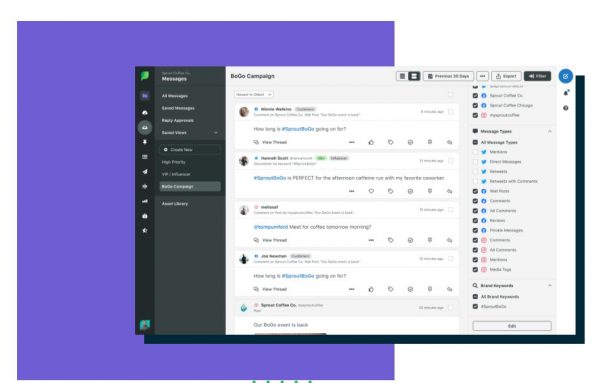

You can “ride” with already trending hashtags or you can create your own, though the latter may take some time to pick up. Riding with a hashtag means using one that’s already widely popular like #TBT (throwback Thursday) or #mondaymotivation. Both strategies are useful but you need to carefully assess when to use them or combine them.
The best social media management tools usually feature some hashtag search or analysis. This tells you which tags are relevant to your brand and posts. It may be tempting to use the ones with millions of followers—people follow hashtags as well, but sometimes, it’s better to narrow it down. For example, instead of using #foodie, you can use one more specific to your location like #foodiesofnewyork especially if you are in the food business.
Tips for Increasing Your Social Engagement
Social engagement is how people interact with your brand on social media. If you want to build a strong brand and social presence, you need to increase your engagement. Get more people to like your posts, and get them to comment and post reviews. It helps you build loyalty in your fans/followers.
Incorporate Images


Studies have shown that posts with images get more clicks, likes, and comments. This is even more important if your products require visual stimulation. Food, beauty, accessories, and clothing are all better marketed if you post photos of them. Limit your use of stock photos. People want to see genuine images.
Add Some Humor
Even if the brand you are building is more authoritative than trendy, it would be good to incorporate some humor as well from time to time. The key is to avoid doing it in a distasteful manner. Make sure that your jokes or humorous posts are not offensive or hostile. In the age of memes, gifs, and puns, it’s only natural for people to engage more if you make use of them.
Be Open to Feedback/Reviews
Some small business owners are tempted to turn their reviews off on Facebook. This may prevent people from posting bad reviews, but they will eventually get the word out. It is also suspicious when a customer sees that there are no reviews on your page. So it’s better to leave this on. If you get some bad reviews, make that a motivation to do better. People will see that your business is improving over time and getting more good reviews than bad ones. That is a better way to redeem your reputation than avoiding bad reviews entirely.
Ask Your Audience to Respond With Emojis
This is a very effective strategy already being used by many brands and artists. Instead of getting people to hit like or heart, you can ask them a question and let them answer with emojis. For example, ask them which product they would like for a giveaway. You can post a collage of four images. Ask them to react with a heart, laugh, sad, or angry emoji for each product to see which wins. It doesn’t matter what the reaction is in this case; the important thing is to get them to interact with you.
Use Live Stories and Videos
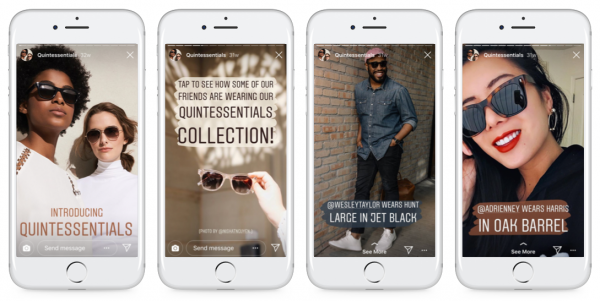

Fans like it when their favorite brands do live stories and videos. As mentioned above, it’s all about telling stories. Give them something to smile or laugh about. This will make them think of your brand when it comes to making purchasing decisions.
Final Word
All the tips mentioned in the latter part of this guide will be made easier by using social media management tools. You may have all the creative ideas in the world but if you don’t have an efficient way to execute them, they still wouldn’t work. So start making your social media calendar with the best tools from the list above and grow your small business today!







